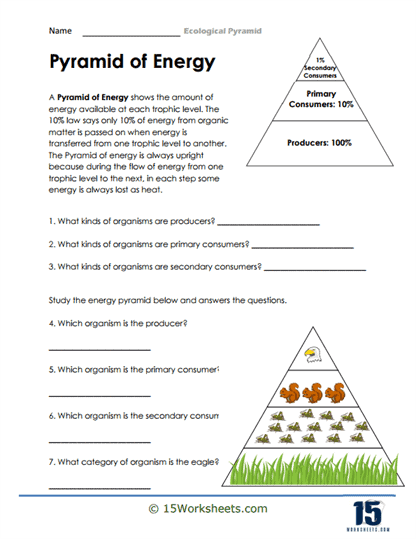Pyramid of Energy

Worksheet Description
This worksheet will help students learn the basic inner workings of these pyramids and how to interpret their data.
The worksheet examines the concept of energy flow within an ecological system. It illustrates how energy gets transferred through various trophic levels, emphasizing that with each transfer, a significant amount of energy is lost, usually as heat. The worksheet introduces the hierarchy of producers, primary consumers, and secondary consumers, elucidating their roles in the ecosystem. Accompanied by an illustrative energy pyramid, it poses a series of questions aiming to test a student’s comprehension of the topic.
To effectively understand and apply the knowledge presented in this worksheet, one must first grasp the fundamental principle that only about 10% of energy is transferred from one trophic level to the next. Students should be able to identify different organisms based on their roles in the ecosystem, categorizing them as producers, primary consumers, or secondary consumers. By studying the provided energy pyramid, they can discern the energy relationships between different species. Answering the questions will then enable them to solidify their understanding and demonstrate their grasp of the material.
This worksheet serves to teach students about the intricate energy relationships within an ecological system. It emphasizes the inherent inefficiency of energy transfer between trophic levels, reinforcing the concept that most energy is lost as heat during each transfer. By providing a visual representation in the form of an energy pyramid, the worksheet makes abstract concepts more tangible for students. Through this hands-on approach, students are encouraged to engage critically with the content, developing a deeper appreciation for the complexities of nature and the interconnectedness of life.
A Pyramid of Energy shows the amount of energy available at each trophic level. The 10% law says only 10% of energy from organic matter is passed on when energy is transferred from one trophic level to another.
The Pyramid of energy is always upright because during the flow of energy from one trophic level to the next, in each step some energy is always lost as heat.
